 W
WThis is a list of cabbage dishes and foods. Cabbage is a leafy green or purple biennial plant, grown as an annual vegetable crop for its dense-leaved heads. Cabbage heads generally range from 0.5 to 4 kilograms, and can be green, purple and white. Smooth-leafed firm-headed green cabbages are the most common, with smooth-leafed red and crinkle-leafed savoy cabbages of both colors seen more rarely. Cabbages are prepared in many different ways for eating. They can be pickled, fermented for dishes such as sauerkraut, steamed, stewed, sautéed, braised, or eaten raw. Cabbage is a good source of vitamin K, vitamin C and dietary fiber. Contaminated cabbage has been linked to cases of food-borne illness in humans.
 W
WBacon and cabbage is a dish traditionally associated with Ireland. The dish consists of sliced back bacon boiled with cabbage and potatoes. Smoked bacon is sometimes used.
 W
WBaechu-kimchi (배추김치), translated as cabbage kimchi or simply kimchi is a quintessential banchan in Korean cuisine, made with salted, seasoned, and fermented napa cabbages.
 W
WA Bayrisch Kraut is a traditional Bavarian dish. It is made of shredded cabbage that is cooked in beef stock with pork lard, onion, apples, and seasoned with vinegar. It is typically served with bratwurst or roast pork but it goes well with other dishes too. In the German cuisine it is an alternative to Sauerkraut.
 W
WBosnian pot is a Bosnian stew, a culinary speciality appreciated for its rich taste and flexibility. Recipes for Bosanski lonac vary greatly according to personal and regional preference, but the main ingredients generally include chunked meat and vegetables. Mixed meats may be used in the dish. It has been described as a national dish of Bosnia.
 W
WZasmażana kapusta, known to many Polish people simply as kapusta [kah-POOS-tah], is a Polish dish of braised or stewed sauerkraut or cabbage, with bacon, mushroom and onion or garlic. It is seasoned with salt, pepper and sometimes bay leaf, caraway seeds, sugar, paprika and apples. The traditional dish is usually served along with boiled potatoes as an accompaniment for pork chops, pork cutlets, other pork dishes, veal, or game meats. In some homes, kapusta is served very thin, almost like a soup. In others, its ingredients are thickened with flour or cooked until it becomes nearly as thick as mashed potatoes. It has been described as less sour in flavor compared to German sauerkraut.
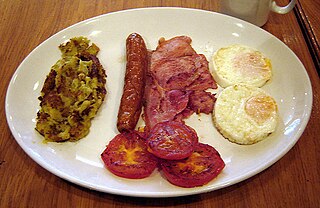 W
WBubble and squeak is a British dish made from cooked potatoes and cabbage, mixed together and fried. The food writer Howard Hillman classes it as one of the "great peasant dishes of the world". The dish has been known since at least the 18th century, and in its early versions it contained cooked beef. By the mid-20th century the two vegetables had become the principal ingredients.
 W
WA cabbage roll is a dish consisting of cooked cabbage leaves wrapped around a variety of fillings. It is common to the cuisines of the Central, Northern, Eastern and Southeastern Europe and much of Western Asia, Northern China, as well as parts of North Africa. Meat fillings are traditional in Europe, and include beef, lamb, or pork seasoned with garlic, onion, and spices. Grains such as rice and barley, mushrooms, and vegetables are often included as well. Fermented cabbage leaves are used for wrapping, particularly in southeastern Europe. In Asia, seafoods, tofu, and shiitake mushrooms may also be used. Chinese cabbage is often used as a wrapping.
 W
WCabbage stew is a stew prepared using cabbage as a primary ingredient. Basic preparations of the dish use cabbage, various vegetables such as onion, carrot and celery, and vegetable stock. Additional ingredients can include meats such as pork, sausage and beef, potatoes, noodles, diced apples, apple juice, chicken broth, herbs and spices, salt and pepper.
 W
WColcannon is a traditional Irish dish of mashed potatoes with kale or cabbage.
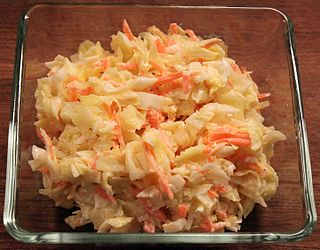 W
WColeslaw, also known as cole slaw or simply slaw, is a side dish consisting primarily of finely shredded raw cabbage with a salad dressing, commonly either vinaigrette or mayonnaise. Coleslaw prepared with vinaigrette may benefit from the long lifespan granted by pickling.
 W
WCurtido is a type of lightly fermented cabbage relish. It is typical in Salvadoran cuisine and that of other Central American countries, and is usually made with cabbage, onions, carrots, oregano, and sometimes lime juice; it resembles sauerkraut, kimchi, or tart cole slaw. It is commonly served alongside pupusas, the national delicacy.
 W
WGołąbki is the Polish name of a dish popular in cuisines of Central Europe, made from boiled cabbage leaves wrapped around a filling of minced pork or beef, chopped onions, and rice or barley.
 W
WHolishkes is a traditional Jewish cabbage roll dish. Holishkes are prepared from lightly boiled ("blanched") cabbage leaves wrapped in a parcel-like manner around minced meat and then simmered in tomato sauce. Sometimes rice is added to the meat filling. While the dish is eaten all year round, it is customarily served on Sukkot to symbolize a bountiful harvest, and on Simchat Torah because two stuffed cabbage rolls placed side by side resemble Torah scrolls.
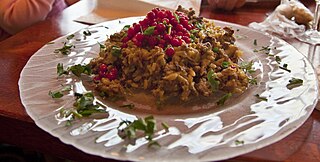 W
WCabbage casserole is a traditional Finnish oven-baked casserole dish, typically made of cabbage, ground meat, rice or pearl barley, and additional flavourings—such as onion, marjoram—and a small amount of syrup or molasses. Kaalilaatikko is usually served with lingonberry aka. cowberry jam.
 W
WKapuska is a hearty traditional Turkish cuisine and Balkan cuisine stew whose name is derived from the Russian language word for cabbage. Although the name is imported, the dish is a Turkish version of a cabbage stew common in Russia and Eastern Europe. Kapuska is widely known and consumed in the Thrace and Black Sea regions of Turkey.
 W
WKimchi, a staple in Korean cuisine, is a traditional side dish of salted and fermented vegetables, such as napa cabbage and Korean radish, made with a widely varying selection of seasonings including gochugaru, spring onions, garlic, ginger, and jeotgal, etc. It is also used in a variety of soups.
 W
WKnieperkohl is a pickled cabbage dish similar to sauerkraut. It contains not only white cabbage but also collard greens and kale, as well as grape leaf and cherry leaf. Knieperkohl is considered a representative dish of the historical region of Prignitz, now part of Brandenburg in Germany.
 W
WLion's Head or stewed meatball is a dish from the Huaiyang cuisine of eastern China, consisting of large pork meatballs stewed with vegetables. There are two varieties: white, and red. The plain variety is usually stewed or steamed with napa cabbage. The red variety can be stewed with cabbage or cooked with bamboo shoots and tofu derivatives. The minced meat rich in fat is more likely to bring better texture, addition of chopped water chestnut also works.
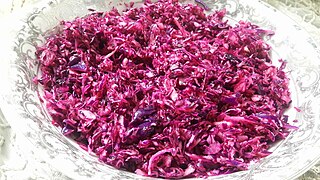 W
WMalfouf salad or cabbage salad, is a Lebanese salad, typically consisting of shredded cabbage, lemon juice, olive oil, garlic, salt and dried mint.
 W
WMaple slaw is a Canadian variation of coleslaw consisting of maple syrup, cabbage, onion, fish, and seasoning.
 W
WRed slaw is a condiment commonly served on hot dogs, on barbecue pork sandwiches, as a side dish for other types of barbecue, on hamburgers, or with other foods. It is an essential part of "Lexington style" North Carolina barbecue.
 W
WRumbledethumps is a traditional dish from the Scottish Borders. The main ingredients are potato, cabbage and onion. Similar to Irish colcannon, and English bubble and squeak, it is either served as an accompaniment to a main dish or as a main dish itself.
 W
WSarma is a dish of vine, cabbage, monk's rhubarb, kale or chard leaves rolled around a filling of grains, like bulgur or rice, minced meat, or both. It is found in the cuisines of the former Ottoman Empire from the Middle East to Southeastern Europe.
 W
WSauerkraut is finely cut raw cabbage that has been fermented by various lactic acid bacteria. It has a long shelf life and a distinctive sour flavor, both of which result from the lactic acid formed when the bacteria ferment the sugars in the cabbage leaves.
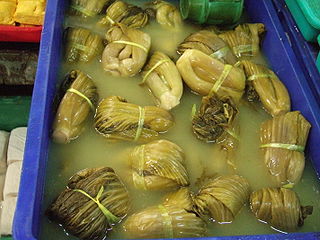 W
WSuan cai is a traditional Chinese pickled Chinese cabbage or Chinese mustard, used for a variety of purposes. Suan cai is a unique form of pao cai, due to the ingredients used and the method of production.
 W
WSurkål is a traditional side dish where the main ingredient is cabbage. It is particularly common in Northern Europe.
 W
WTianjin preserved vegetable is a type of pickled Chinese cabbage originating in Tianjin, China. It consists of finely chopped Tianjin cabbage and salt. Garlic is also generally added in the pickling process, although it is omitted in versions prepared for consumption by members of certain Chinese Buddhist sects, who practice strict Buddhist vegetarianism and do not consume garlic or other spicy foods. This pickled vegetable is used to flavor soups, stir fries or stewed dishes.
 W
WTrinxat is a food from the Pyrenees, principally Andorra and the Catalan comarcas of Cerdanya and Alt Urgell. It is made with potatoes, cabbage and pork meat, and resembles bubble and squeak. The name, meaning “mashed” or “chopped”, is the past participle of the Catalan word trinxar, which means "to slice". It is sometimes served with salt herring or eaten on its own with bread.
 W
WWedding cabbage is traditional Serbian dish. The main ingredients are cabbage and a meat, which could be pork, bacon, or lamb and mutton. This dish is typically prepared by cooking it slowly for many hours in a big crock. It is traditionally served at weddings and other major events.